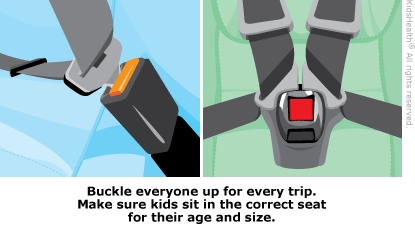Your child was in a motor vehicle crash. The health care provider checked your child and found no serious injuries. Your child may have some bruising and muscle soreness from being bumped around in the crash. They should feel better in about a week. You can now care for your child at home.

Your child:
- Has pain that doesn't get better with pain medicine
- Has pain that lasts for more than a few days or that gets worse
- Has pink, brown, or tea-colored urine (pee) or black poop (these can be signs of a belly injury)
- Gets a headache, starts vomiting, is irritable or cranky, cannot be calmed down, or is not acting like themself (these can be signs of a head injury)
You know your child best. If they have any symptoms that worry you, call your health care provider.

What can parents do to keep kids safe in cars? It helps to:
- Use the right car seat: Make sure your child is in the appropriate car seat for their age, weight, and height. Follow the manufacturer's guidelines and install the seat correctly.
- Buckle up: Always make sure that everyone in the car, including the driver, is wearing a seatbelt.
- Follow speed limits: Obey speed limits and adjust your speed according to weather and road conditions. Driving at a safe speed gives you more time to react to unexpected situations.
- Avoid distractions: Keep your focus on the road. Avoid using your phone, eating, or doing anything else that takes your attention away from driving. If you need to use your phone, pull over to a safe location.
- Stay alert: Be aware of your surroundings and other drivers. Watch for pedestrians, cyclists, and other vehicles, especially in school zones and residential areas.
- Maintain your vehicle: Regularly check your car's brakes, tires, lights, and other important systems.
- Plan your route: Before you start driving, plan your route and check for any potential hazards or road closures. This can help you avoid stressful or dangerous situations.
- Use child safety locks: If your car has child safety locks, use them to prevent children from opening the doors while the car is in motion.
- Stay calm and patient: Driving can be stressful, but staying calm and patient can help you make better decisions and avoid accidents. Being calm and patient while driving will teach your kids to stay calm in the car too.




